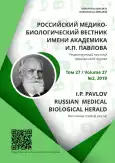Local hemostatic agents and ways of their improvement
- Authors: Budko E.V.1, Chernikova D.A.1, Yampolsky L.M.1, Yatsyuk V.Y.1
-
Affiliations:
- Kursk State Medical University
- Issue: Vol 27, No 2 (2019)
- Pages: 274-285
- Section: Reviews
- URL: https://journals.rcsi.science/pavlovj/article/view/14552
- DOI: https://doi.org/10.23888/PAVLOVJ2019272274-285
- ID: 14552
Cite item
Abstract
Recently, local hemostatic agents (LHA) have become increasingly popular abroad and in our country. They act in a targeted way and can be used both in damage to large vessels and in diffuse bleeding. In the article, chemical nature, physical and chemical characteristics of materials and mechanisms of LHA activity are considered, directions of their improvement are shown. LHA are mostly classified by mechanism of action.
To date, the popular groups of hemostatic agents are «mucoadhesive agents» (chitosan, amylopectin) and «coagulation factors concentrators» (zeolites, kaolin). Other authors distinguish the group of «aggregation and adhesion stimulants» (collagen, cellulose). Here, representatives of these groups have common characteristics – very high porosity and hydration ability. Another group includes substances that «promote protein denaturation» (inorganic salts of metals, as well as salts of acrylic acid and its derivatives). Polyacrylates are the basis of adhesives with hemostatic activity. However, most modern LHA are complex drugs and it is just this group that is most promising. All means, from hemostatic sponges produced by Zelyonaya Dubrava (Russia) and Nycomed, Takeda (Austria, Norway), and to hemostatic materials of MedTrade manufacture (Great Britain), Etiguette and Z-Medica (USA), combine sorption and, actually, thrombotic properties. The trademarks often imply original compositions and, especially, technologies: Quick Relief, BioSeal, BallistiClot, Hemaderm, CELOX Gauze PRO, OMNI-STAT Hemostatic Gauze for minor external bleeding. The most effective LHA are those based on chitosan and kaolin in the form of dressings with embedded clot-forming substance, for example, with artificial platelets or other coagulation factors.
Full Text
##article.viewOnOriginalSite##About the authors
Elena V. Budko
Kursk State Medical University
Email: vestnik@rzgmu.ru
ORCID iD: 0000-0001-8861-7491
SPIN-code: 1517-2863
ResearcherId: Н-2806-2013
PhD in Pharmaceutical Sciences, Professor, Head of the Department of General and Bioorganic Chemistry
Russian Federation, KurskDaria A. Chernikova
Kursk State Medical University
Email: vestnik@rzgmu.ru
ORCID iD: 0000-0002-3540-6700
SPIN-code: 7440-0789
PhD-Student of the Department of General and Bioorganic Chemistry
Russian Federation, KurskLeonid M. Yampolsky
Kursk State Medical University
Author for correspondence.
Email: yampolsky.leonid@yandex.ru
ORCID iD: 0000-0001-7575-9140
SPIN-code: 6556-5302
PhD in Chemical Sciences, Associate Professor of the Department of General and Bioorganic Chemistry
Russian Federation, KurskValentina Y. Yatsyuk
Kursk State Medical University
Email: vestnik@rzgmu.ru
ORCID iD: 0000-0002-7954-9076
SPIN-code: 7605-3467
PhD in Pharmaceutical Sciences, Professor, Professor of the Department of General and Bioorganic Chemistry
Russian Federation, KurskReferences
- Samokhvalov IM, Reva VA, Pronchenko AA, et al. Local hemostatic measures: the new era in delivery of prehospital aid. Polytrauma. 2013;(1):80-6. (In Russ).
- Petlakh VI. Results of Use of Local Hemostatics in Disaster Medicine. Disaster Medicine. 2014;4(88): 21-4. (In Russ).
- Galanakis I, Vasdev N, Soomro N. A Review of Current Hemostatic Agents and Tissue Sealants Used in Laparoscopic Partial Nephrectomy. Reviews in Urology. 2011;13(3):131-8. doi: 10.3909/riu0524
- Lutsevich OE, Grin AA, Bichev AA, et al. Features of the application of hemostatic material topical surgery. Moscow Surgical Journal. 2016;49(3):12-20. (In Russ).
- Kumar SMP. Local hemostatic agents in the mana-gement of bleeding in oral surgery. Asian Journal Pharmaceutical and Medical Research. 2016;9(3): 35-41.
- Achneck HE, Sileshi B, Jamiolkowski RM, et al. A Comprehensive Review of Topical Hemostatic Agents Efficacy and Recommendations for Use. Annals of Surgery. 2010;251(2):217-28. doi:10.1097/ SLA.0b013e3181c3bcca
- Belozerskaya GG, Makarov VA, Zhidkov EA, et al. Local hemostatics (a review). Pharmaceutical Chemistry Journal. 2006;40(7):9-15. (In Russ). doi: 10.30906/0023-1134-2006-40-7-9-15
- Samokhvalov IM, Golovko KP, Reva VA, et al. Usage of local hemostatic agent «Celox» in experimental model of massive external bleeding. Vestnik Rossiyskoy Voyenno-Meditsinskoy Akademii. 2013;44(4):187-91. (In Russ).
- Molchanova AA, Grinberg VB, Kushikov KT. Blood vessels in histological preparations. Herald ASIAME. 2018;(2):23-6. (In Russ).
- Bunatyan AG, Zavenyan ZS, Bagmet HH, et al. Problemy gemostaza i germetizma pri rezektsiyakh pecheni s ispol’zovaniyem fibrin-kollagenovoy substantsii. Khirurgiya. Zhurnal imeni N.I. Pirogova. 2003;(9):18-23. (In Russ).
- Istranov LP, Aboyants RK, Belozerskaya GG, et al. Collagen-based local hemostatics. Pharmacy. 2007; (7):29-32. (In Russ).
- Romantsov MN, Cherednikov EF, Danilenko VI, et al. Morphological Characteristics of Processes of Simulated Bleeding Gastric Defects Reparation in Treatment with Gelplastan and Diovin. Žurnal Anatomii i Gistopatologiii. 2017;6(1):81-6. (In Russ). doi: 10.18499/2225-7357-2017-6-1-81-86
- Skryabin KG, Vikhoreva GA, Varlamov VP. Khitin i khitozan. Polucheniye, svoystva i primeneniye. Moscow: Nauka; 2002. (In Russ).
- Chan LW, Kim ChH, Wang X, et al. PolySTAT-Modified Chitosan Gauzes for Improved Hemostasis in External Hemorrhage. Acta Biomaterialia. 2016;31:178-85. doi: 10.1016/j.actbio.2015.11.017
- Hu Zh, Ouyang QQ, Cheng Y, et al. Optimization of preparation process and characterization of carboxymethyl chitosan/sodium alginate hemostatic sponge. IOP Conference Series: Materials Science and Engineering. 2017;213:012045. doi:10.1088/ 1757-899X/213/1/012045
- Antisdel JL, West-Denning JL, Sindwani R. Effect of microporous polysaccharide hemospheres (MPH) on bleeding after endoscopic sinus surgery. Randomized controlled study. Otolaryngology – Head and Neck Surgery. 2009;141(3):353-7. doi:10.1016/ j.otohns.2009.06.078
- Achneck HE, Sileshi B, Jamiolkowski M, et al. A Comprehensive Review of Topical Hemostatic Agents. Annals of Surgery. 2009;251(2):217-28. doi: 10.1097/SLA.0b013e3181c3bcca
- Plotkin AV, Pokrovskij EZh, Voronova GV, et al. The evaluation of the effectivity of hemostatic activity of Haemoblock for local topical use Haemoblock in different surgical situations. Multicenter clinical trials. Vestnik Sovremennoi Klinicheskoi Mediciny. 2015;8(1):56-61. (In Russ).
- Chan LW, Wang X, Wei H, et al. A Synthetic Fibrin-Crosslinking Polymer for Modulating Clot Properties and Inducing Hemostasis. Science Translational Medicine. 2015;7(277):1-11. doi:10.1126/ scitranslmed.3010383
- Travers S, Lefort H, Ramdani E, et al. Hemostatic dressings in civil prehospital practice: 30 uses of QuikClot Combat Gauze. European Journal of Emergency Medicine. 2016;23(5):391-4. doi:10.1097/ MEJ.0000000000000318
Supplementary files







